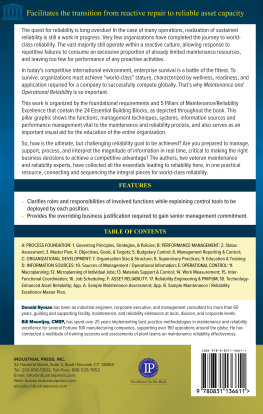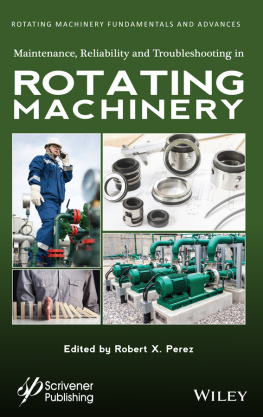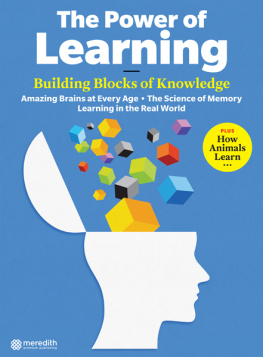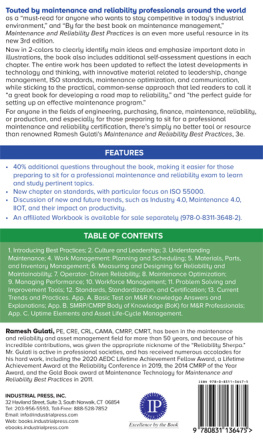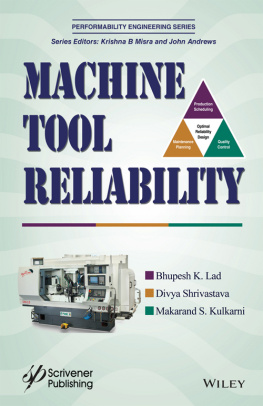Nyman Donald H. (author) - Maintenance and Operational Reliability: 24 Essential Building Blocks
Here you can read online Nyman Donald H. (author) - Maintenance and Operational Reliability: 24 Essential Building Blocks full text of the book (entire story) in english for free. Download pdf and epub, get meaning, cover and reviews about this ebook. genre: Romance novel. Description of the work, (preface) as well as reviews are available. Best literature library LitArk.com created for fans of good reading and offers a wide selection of genres:
Romance novel
Science fiction
Adventure
Detective
Science
History
Home and family
Prose
Art
Politics
Computer
Non-fiction
Religion
Business
Children
Humor
Choose a favorite category and find really read worthwhile books. Enjoy immersion in the world of imagination, feel the emotions of the characters or learn something new for yourself, make an fascinating discovery.
- Book:Maintenance and Operational Reliability: 24 Essential Building Blocks
- Author:
- Genre:
- Rating:4 / 5
- Favourites:Add to favourites
- Your mark:
- 80
- 1
- 2
- 3
- 4
- 5
Maintenance and Operational Reliability: 24 Essential Building Blocks: summary, description and annotation
We offer to read an annotation, description, summary or preface (depends on what the author of the book "Maintenance and Operational Reliability: 24 Essential Building Blocks" wrote himself). If you haven't found the necessary information about the book — write in the comments, we will try to find it.
Maintenance and Operational Reliability: 24 Essential Building Blocks — read online for free the complete book (whole text) full work
Below is the text of the book, divided by pages. System saving the place of the last page read, allows you to conveniently read the book "Maintenance and Operational Reliability: 24 Essential Building Blocks" online for free, without having to search again every time where you left off. Put a bookmark, and you can go to the page where you finished reading at any time.
Font size:
Interval:
Bookmark:


MAINTENANCE &
OPERATIONAL
RELIABILITY
The 24 Essential Building Blocks
The Transition from Reactive Repair to Reliable Asset Capacity
DON NYMAN AND BILL MOUNTJOY
INDUSTRIAL PRESS, INC.
MAINTENANCE &
OPERATIONAL
RELIABILITY
MAINTENANCE &
OPERATIONAL
RELIABILITY
I am eternally grateful for my recently departed wife Barbara Ann (Spender) Nyman and dedicate this book to her. We were married 63 years. Counting courtship years beginning in high school, we were together 69 years.
Our family numbers four children, eleven grandchildren, and eight great grandchildren, plus another eight associated in-laws. All are wonderful and loving. Due to the rigors of business travel, a disproportionate amount of associated rearing was lovingly provided by Barbara.
Given the overriding challenges in todays competitive global environment, with quickly changing technology, enterprise survival is a battle of the fittest. To survive, organizations must achieve world-class stature; world-class being the popular term referring to the state of wellness, readiness, and application required for an enterprise to successfully compete internationally and to survive. World-class is achieved by identifying and emulating the current best practices to be deployed in each aspect of the industry in which the company operates. Thereby, the organization becomes equal to or better than any potential competitor, assuming fair trade without governmental interference.
Within the operational arena of any enterprise, reliability is of paramount importance. It is achievable only within a proactive culture that nurtures maintenance excellence, the vehicle that makes the ultimate goal of asset reliability a reality.
THE EVOLUTION OF MAINTENANCE AND RELIABILITY
Necessity of equipment repair began with the industrial revolution during the mid- and late-19th century. Prior to that time, people who produced products were artisans capable of maintaining their own simple equipment. As equipment became more advanced, the need arose for specialized personnel dedicated to the maintenance and repair of the operational assets. Eventually, maintenance departments came into being. In recent years, maintenance has evolved into the current state of sophisticated technology tools, and the capability of real-time data collection and analysis. Figure P.1 shows some of the key progression methodologies and the relative decades in which they came into broader common practice.
For decades, expectations placed on maintenance were simple and limited: essentially repair equipment upon failure and return it to operational state as quickly as possible. Not much changed in this regard until after World War II, after which management began to apply scientific management concepts (primarily to production functions, not yet to maintenance).
By the 1950s and 60s, the function offering the greatest opportunity for additional improvement (largely cost reduction) became maintenance. Ever since, there has been a steady stream of methodologies applied to improvement of the function. Pursuing cost reduction within the maintenance budget itself, early efforts (led by Industrial Engineering) focused upon crew efficiency.
Manual work order systems. Throughout this time period, most work orders (WOs) were manual. In some cases, WO input was transferred to keypunch cards and processed through mainframe computers. The output was periodic (weekly or monthly), hard copy reports. Information was managerial rather than operational in nature.
Universal Maintenance Standards (UMS). By the early 60s, larger operations on the leading edge of maintenance management were applying UMS. This entailed the application of predetermined times for micromotions in order to build standard times for individual maintenance jobs.

FIGURE P.1 Historical Progression of Maintenance and Reliability Excellence
Job planning and scheduling. UMS standards were used to schedule jobs and measure crew performance. The nomenclature for the associated staff personnel was planner/applicator. This position was the forerunner of planner/schedulers. See Chapter 14 for further discussion.
Programmed maintenance (overhauls, rebuilds, and corrections). Analysis of these work types led to the setting of fixed time periods between planned, proactive overhauls, rebuilds, and inspections that are dependent upon access to idle equipmentpotentially for days. Analysis of the time duration between specific equipment failures would be used to calculate the economic run times so that restoration shutdowns could be accurately scheduled. Run time was quantified either in terms of hours operated or calendar period.
From the 1970s through the 1990s, the computer age provided more sophisticated ways to track and manage maintenance activities as well as improve the means of accumulating, analyzing, and reporting historical data. During this time, a multitude of reliability improvement methodologies were starting to evolve and became more prevalent in U.S. manufacturing operations.
Computerized Maintenance Management Information Systems (CMMIS). The initial systems were originally programmed in-house. Then came preprogrammed packages offered by numerous software houses. They were primarily work order systems providing basic maintenance-related information to accounting, materials management, and maintenance. Whether internally or externally programmed, most of these systems were specified and programmed with little input from experienced maintenance management practitioners. Commonly, the input that maintenance did offer came from reactive not proactive experience.
Note: The authors have frequently used the acronym CMMIS over the commonly used CMMS. Too many people look upon the system as a comprehensive solution. It is far from the complete answer, as this book makes clear. It is only a tool for the informational portion of the challenge. You will see it used throughout the book.
Total Productive Maintenance (TPM). This approach stemmed from successful efforts in Japan to improve reliability. It applies concepts of total quality control, employee involvement, group activities, covenant relationships, and operator training enabling them to share responsibility for routine inspections, cleanings, and minor repairs with maintenance personnel (autonomous maintenance). TPM also identified and addressed the six big losses obstructing equipment effectiveness and emphasized the essentialness of predictive maintenance and failure prevention concepts. TPM and the six big losses are discussed further in
Reliability Centered Maintenance (RCM). This was developed by the international aviation industry in the 1970s. During the 90s, its popularity spread to other industries in the United States and other industrialized countries. It has been described as a process used to determine maintenance requirements of any physical asset in its operating context, ensuring that physical assets continue to do what they were specified and designed to do. Many organizations apply one or more RCM tools, such as Failure Modes Effects and Criticality Analysis (FMECA) to determine consequences of various failure types with proactive actions for their detection and avoidance. The potential failure to functional failure interval (P-F Curve) is the time between when the potential equipment failure is detected and the actual failure occurs, meaning failure to perform all functions for which the equipment was designed. Effective application of these disciplines requires dedication of specialized engineering skills. Hence, the introduction of Reliability/Maintenance Engineering.
Next pageFont size:
Interval:
Bookmark:
Similar books «Maintenance and Operational Reliability: 24 Essential Building Blocks»
Look at similar books to Maintenance and Operational Reliability: 24 Essential Building Blocks. We have selected literature similar in name and meaning in the hope of providing readers with more options to find new, interesting, not yet read works.
Discussion, reviews of the book Maintenance and Operational Reliability: 24 Essential Building Blocks and just readers' own opinions. Leave your comments, write what you think about the work, its meaning or the main characters. Specify what exactly you liked and what you didn't like, and why you think so.

